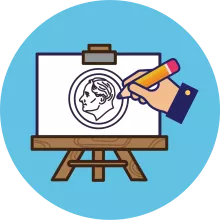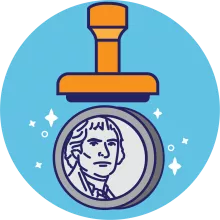A circulating coin begins its life as an idea. Once the U.S. Mint designs and makes the coin, it gets passed around to people and businesses before it retires. Follow the life of a coin in the steps below.
Before the Mint designs a coin, Congress tells us to make new coins by passing a law. Sometimes the law includes certain designs that must be put onto the coins, like people or places.
Once Congress passes a law, the Mint's work starts and the coin is born.
Design
Coins are like tiny art pieces that fit in your pocket. Coins show people, objects, or symbols. They also include text called inscriptions. Learn about the parts of a coin.
To design a coin, a Mint artist draws a sketch of what they want the coin to look like (1). The artist uses their sketch to sculpt a 3-D clay or digital model (2). The Mint uses the model to transfer the design onto a metal stamp, called a die (3). The die stamps the design onto the coins. Learn more about coin designs.

Coin Making
The Mint makes most circulating coins from large sheets of metal rolled into coils. Imagine a big roll of wrapping paper! The metal of the coil matches the types of metal in the finished coin.
Round discs called blanks are punched out from the metal sheet. The blanks are heated to make them softer and then washed. They pass through a machine that squeezes them, forcing the sides up to form a rim. The coin press uses the die to stamp the blanks with the coin design. Mint employees inspect the coins to make sure there are no flaws. The coins are counted and weighed, then put into large bags to send all over the country.
Follow the process in the video below.
Use
The Mint sends the shiny new coins to Federal Reserve Banks (Deliver). From there, they go to local banks across the country to enter circulation.

Fun Fact! The Mint makes new coins each year, but they make up less than 20% of the total coins in circulation. More than 80% comes from people re-using coins to pay for goods and services.
Coins are "in circulation" when we use them as money. They get passed around from banks, stores, and people over and over again (Circulate). You use your coins to buy something from a store. The store takes your coins to the bank. The bank then gives the coins to another store, and so on.
If you save coins in your piggy bank, it takes them out of circulation (Save).

Retire
Coins can last around 30 years in circulation before they're too worn to use. When coins reach the end of their life, the Federal Reserve removes them from circulation. Old coins are melted down and used for other things.







